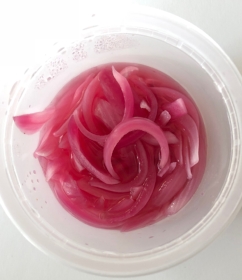Kale Salad with Pears, Pomegranates, and Pickled Onions
/Every Thanksgiving table should include a big, fresh salad. With all the rich casseroles, gravy, and savory (and sometimes surprisingly sweet) sides, something fresh is a necessity. Whenever I bust up a big salad into the Turkey Day mix, I’m often met with jokes and gentle ribbing. But you know what? My salad always gets eaten. Every freaking leaf. This is a great one for Thanksgiving or Friendsgiving because it can easily accommodate dietary needs and restrictions: It’s vegan and gluten-free, and if someone has a nut allergy, you can easily omit the pecans.
The first step for this salad is to make a batch of pickled onions. I have you make double what you need for the salad—because why not go ahead and use a whole onions?
The leftover pickled onions will hold up well in the fridge for a couple of weeks, and you can use them on tacos, other salads, grain bowls, and more. My easy two-ingredient method relies on two products from the Asian foods aisle: mirin and rice vinegar. These guys:
You can find rice vinegar at any supermarket and mirin at most (I got mine at Target). The mirin is seasoned with salt and sugar plus has a pleasant, light wine flavor—so it takes the place of wine, salt, and sugar. The rice vinegar is softer than many other vinegars, which could make the pickled onions sharp and wince-inducing.
I love lacinato kale for its bumpy texture and earthy and faintly sweet flavor. If you can’t find it, you can use regular curly kale—just know that it’s a little tougher. No matter which you use, do take a minute or two to massage the leaves with a little oil first, to help break down the fibers and tenderize the leaves.
As for the pears, as I mentioned above, I lucked into some gorgeous Seckel pears at the Publix down the road. They come in a bag, like this:
And they’re smaller than most pears. See?
Now for the pomegranates. Look, I know that the arils you can buy in the little cups are very convenient. I’ve used them myself on more than one occasion. But they just don’t taste as good as ones you pull fresh from the whole fruit. I learned a trick that makes that process a little easier. First, cut about 1/4-inch off the top of the fruit, like so:
One you take the “lid” off, you can see where the paper-thin membranes are. It’s a little tricky to see in the photo above, but look for the spoke-like thin white membranes that grow out from the core. You want to score the outer skin of the pomegranate where those membranes run, from the top to the bottom of the fruit, like this:
Once the skin is scored, you can pull apart the fruit. It will break along those “fault lines” like so—
Now you can just gently prod those arils out without having to pick through all the pith and membrane. I swear it’s worth the effort (and there’s not much effort to it).
This salad will fill a big ol’ bowl (meaning it makes a lot). But I predict it will all get happily eaten, with thanksgiving.








